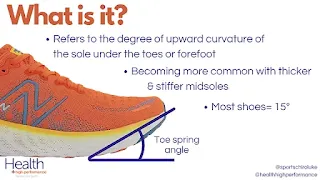Forefoot rockers in footwear
Forefoot rockers in footwear
What
is a forefoot Rocker!
Footwear with a forefoot rocker, commonly called a (½) rocker
sole, toe spring and Meta rocker (Hoka) refers to the degree of upward curvature of the
sole under the toes or forefoot.
An increased forefoot rocker or toe spring angle decreased toe work & decreased range of movement of the toe joints (The metatarsophalangeal (MTP) joints) when walking.
Shoe rocker: what is it & who is it useful for? (healthhp.com.au)
Some of the
reasons to include forefoot rocker or toe spring in a shoe is to help reduce
discomfort due hallux limitus (big toe arthritis), osteoarthritis and
rheumatoid arthritis of the forefoot and ball-of-foot pain by reducing the
motion in the toe.
Shoes with fore rocker are also beneficial for people with
diabetes that need to redistribute their plantar pressure. Reducing peak
plantar pressures in the medial forefoot, central forefoot and toe regions
compared to the flatter style shoe therefore reduces the risk of ulcerations in
the foot. A forefoot rocker would also help with Morton’s neuroma by off-loading forefoot pressure. Note.
People with Morton’s neuroma need very low or zero drop shoes thus taking the
pressure on the bones in the ball of the feet (where your Morton’s neuroma is
located)
Another benefit of
forefoot rocker (toe spring) you will find in athletic shoes. This help runners
who land on their forefoot get a faster transition to toe-off and rely less on
ankle flexion. The toe rocker adds a feeling of being propelled forward without
taking away from the runner's natural gait. This is prevalent in running shoes with thicker midsoles
and stiffer soles. These type of athletic shoe have been found to reduce load
and force on the Achilles tendon, forefoot, toe joints and foot relief and
ability to continue running/walking.




Comments
Post a Comment